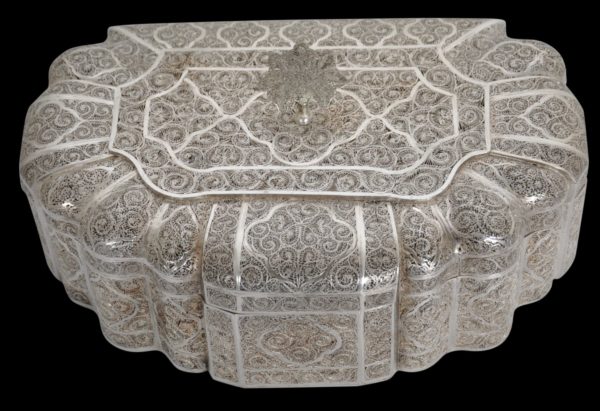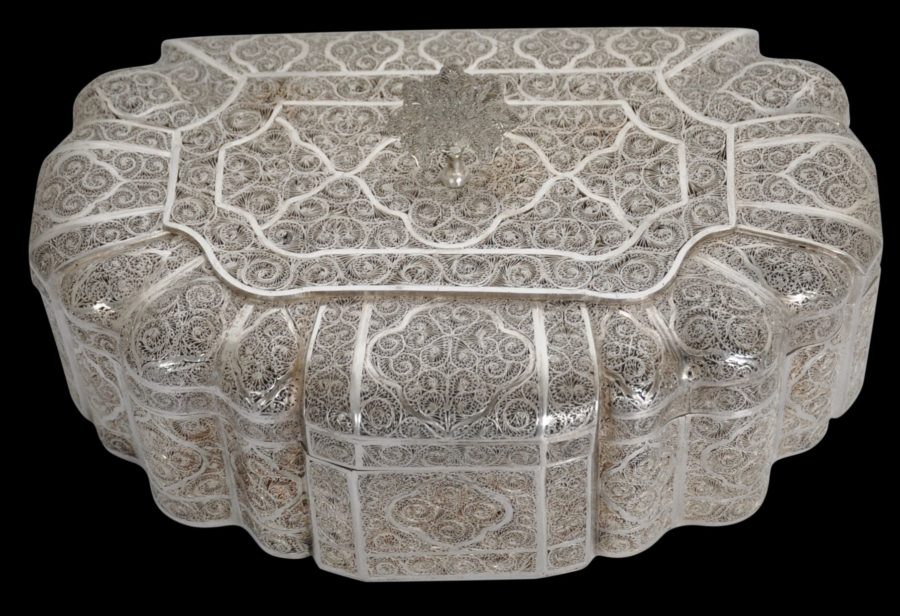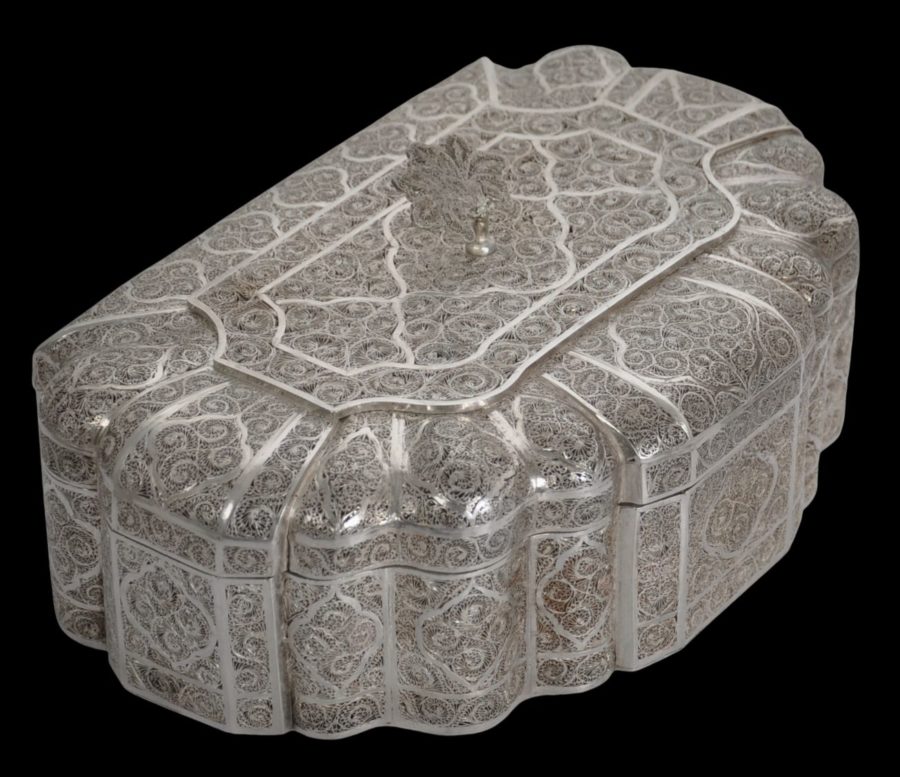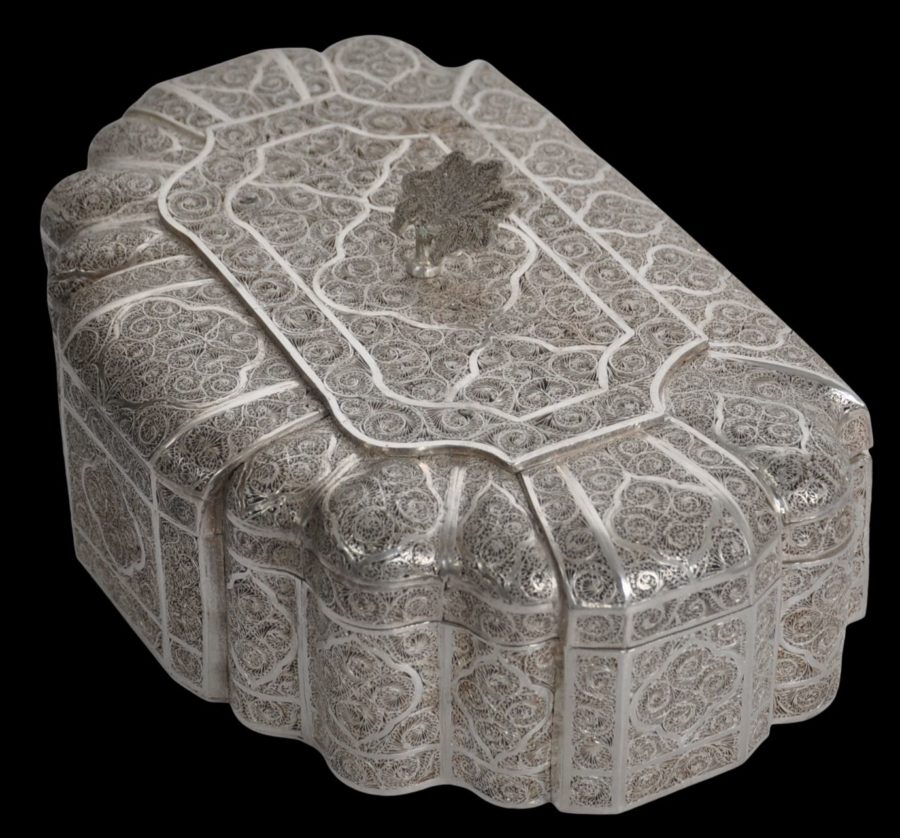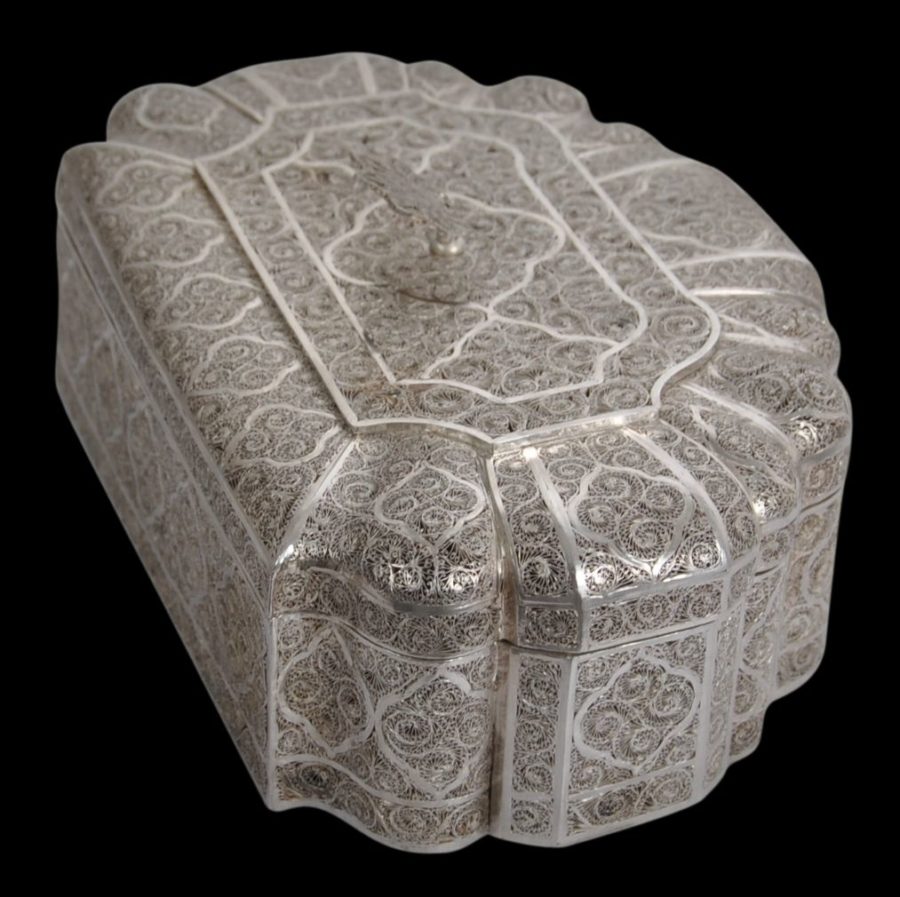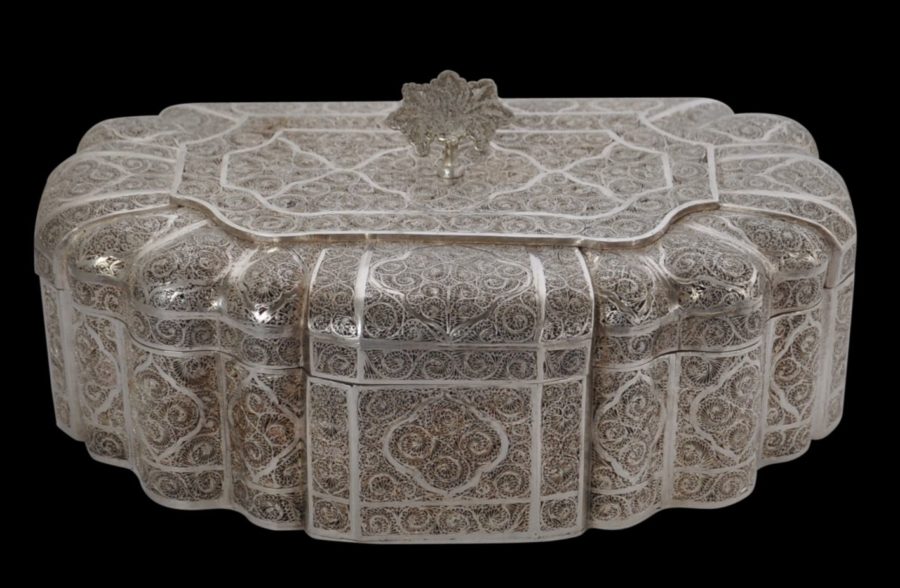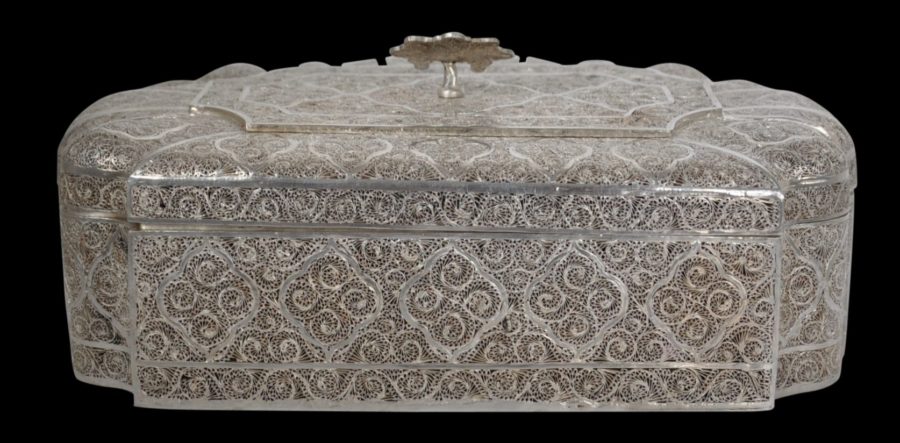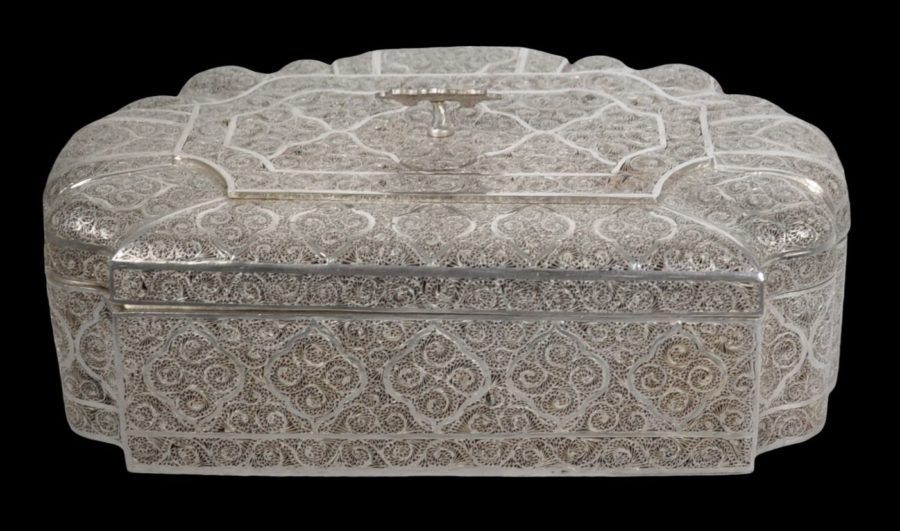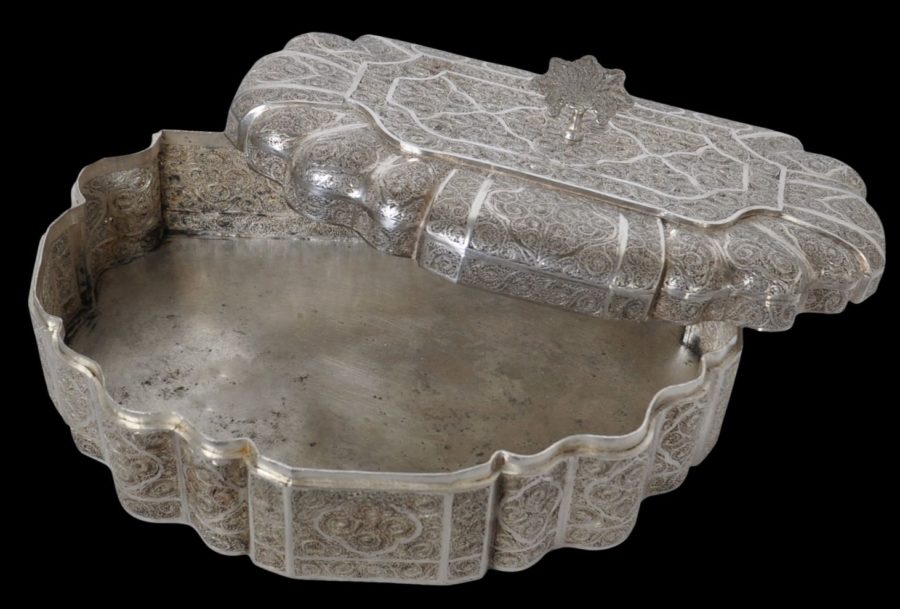This large and surprisingly heavy box (it weighs more than a kilogram) has been made of almost pure silver. It has been constructed of fine silver filigree with a hammered sheet silver base, and is most probably the product of silversmiths working in colonial Batavia in the Dutch East Indies (Indonesia today). Some researchers argue that such filigree work was produced in India because examples are sometimes found in India but we believe it more likely that it was exported to India, for the local Islamic market, and was done so as part of the intra-Asia trade undertaken by the Dutch East Indies Company (VOC).
The rococo-inspired, clam-like shape is very unusual – it is the only Dutch colonial silver filigree box in this shape of which we are aware.
The back of the box is long and straight but the front and the sides are scalloped with eleven curves.
The top edges of the lid are rounded leading to a raised, but flat top. The lid is surmounted by a palm or cabbage-like leafy pull finial. The lid is not hinged.
The filigree comprises fine curved silver wires arrayed between broader, flatter wires. Floral and geometric patterns are used, as well as many fine borders utilising a zig-zag filigree pattern. The flower motif in the middle of the tray is augmented by a central silver spherical granule at its centre.
The patterning is similar to a 17th-18th century silver filigree box that was most probably made in Batavia and which had the cypher of England’s Queen Adelaide (1792-1849) that we had in the past and which is now in the collection of the Art Gallery of South Australia (see Bennett & Kelty, 2014, p. 99).
Usually such filigree items are ascribed to India, often Goa. But many such examples were made in the East Indies on behalf of the Dutch East Indies Company (VOC). Examples found in India were not necessarily made there but are likely to have been traded there by the VOC from Batavia.
Items with similar styles of filigree that are attributed to either India or Southeast Asia are illustrated in Piotrovsky (2006. pp. 64-67).
The main objective of the VOC was to bring spices from Asia to Europe. But the VOC also established a complex series of intra-Asia trade networks whereby items were purchased in one part of Asia to be sold in another for profit. One study identifies 1,059 ships in the employ of the VOC which routinely took part in trade within Asia between 1595 and 1660 (Parthesius, 2010, p. 13). Textiles were a mainstay of intra-Asia trade but other consignments included luxury goods, timber, Chinese porcelain, and even elephants. Items of silver were produced in and near Batavia at the behest of the VOC and there was a history of silver filigree production in the area. William Marsden in his treatise on Sumatra first published in 1784 includes an extensive description of gold and silver filigree work carried out in Sumatra, with the observation that: ‘there being no manufacture in that part of the world, and perhaps I might be justified in saying, in any part of the world, that has been more admired and celebrated than the fine gold and silver filigree of Sumatra. This indeed is, strictly speaking, the work of the Malayan inhabitants’. He adds that ‘The [local] Chinese also make filigree, mostly of silver, which looks elegant, but wants likewise the extraordinary delicacy of the Malayan work.’ Sumatra was an important market for Indian-made textiles imported by the VOC. Pepper and gold were among the goods that the VOC received in payment. Undoubtedly, filigree work was too, all of which would have been trans-shipped through Batavia. It is a possibility that has been explored by Veenendaal (2014) who illustrates a series of chests with similar filigree which he attributes to West Sumatra, circa 1700.
The box here is in fine condition with no obvious losses. The shape is unusual and very pleasing. The silver used is likely to be as close to being pure as is possible (sterling silver by way of example is not pure silver but only 92.5% silver). The box has a lovely patina and obvious age.
References
Bennett, J., & R. Kelty, Treasure Ships: Art in the Age of Spices, Art Gallery of South Australia, 2014.
Corrigan, K., J. van Campen, & F. Diercks (eds.), Asian in Amsterdam: The Culture of Luxury in the Golden Age, Peabody Essex Museum/Rijksmuseum, 2015.
Eliens, T.M., Silver from Batavia/Zilver uit Batavia, Gemeentemuseum Den Haag/W Books, 2012.
Jordan, A. et al, The Heritage of Rauluchantim, Museu de Sao Roque, 1996.
Marsden, P., The Wreck of the Amsterdam, Hutchinson, 2nd ed., 1985.
Marsden, W., The History of Sumatra: Containing an Account of the Government, Laws, Customs and Manners of the Native Inhabitants, with a Description of the Natural Productions, and a Relation of the Political State of that Island, 1784.
Parthesius, R., Dutch Ships in Tropical Waters: The Development of the Dutch East India Company (VOC) Shipping Network in Asia 1595-1660, Amsterdam University Press, 2010.
Piotrovsky, M. et al, Silver: Wonders from the East – Filigree of the Tsars, Lund Humphries/Hermitage Amsterdam, 2006.
Veenendaal, J., Asian Art and the Dutch Taste, Waanders Uitgevers Zwolle, 2014.
Voskuil-Groenewegen, S.M. et al, Zilver uit de tijd van de Verenigde Oostindische Compagnie, Waanders Uitgevers, 1998.


